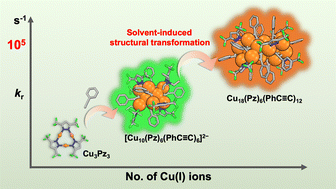Enhancing photoluminescence efficiency of atomically precise copper(i) nanoclusters through a solvent-induced structural transformation†
Abstract
Atomically precise copper(I) nanoclusters (CuNCs) with high photoluminescence (PL) efficiency and a relatively short lifetime could be promising non-precious metal-based phosphorescent emitters for organic light-emitting diodes (OLEDs), but the synthesis of such CuNCs still remains a great challenge. Herein, we have prepared a parallelepiped-like and green emissive atomically precise Cu10 alkynyl cluster with a moderate PLQY of 35% and lifetime (τav) of 8.4 μs. Interestingly, upon addition of hexane to a DCM solution of Cu10, it turns into an hourglass-like, orange emissive Cu18 cluster with an enhanced PL efficiency (PLQY = 63%, and τav = 2.8 μs) at room temperature, which is rarely achieved in high-nuclearity alkynyl-protected CuNCs. Experiments and theoretical calculations suggested that the excellent PL performance of Cu18 is due to reduced nonradiative transition, a larger d orbital contribution of Cu ions, an enhanced transition dipole moment and reduced HOMO–LUMO gap. This work will not only pave a novel approach for constructing alkynyl-protected CuNCs with a high PLQY and short lifetime, which might be explored for other CuNCs for fabricating high-performance OLEDs, but also shed light on the structure–luminescence relationship.

- This article is part of the themed collections: Inorganic Chemistry Frontiers Emerging Investigator Series 2022–2023 and FOCUS: Metal and Metal-Containing Clusters


 Please wait while we load your content...
Please wait while we load your content...